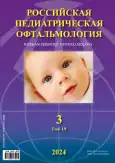Effect of bifocal soft contact lenses in combination with instillations of the combined drug (Phenylephrine 5% and Tropicamide 0.8%) on the anatomical and functional parameters of the eyes and progression of myopia in pediatric patients
- Authors: Tarutta E.P.1, Tarasova N.A.1, Milash S.V.1, Harutyunyan S.G.1, Markosyan G.A.1
-
Affiliations:
- Helmholtz National Medical Research Center of Eye Diseases
- Issue: Vol 19, No 3 (2024)
- Pages: 147-159
- Section: Original study article
- URL: https://journal-vniispk.ru/1993-1859/article/view/273453
- DOI: https://doi.org/10.17816/rpoj633233
- ID: 273453
Cite item
Abstract
AIM: The study aimed to assess the influence of combined optical and pharmacological effects on the anatomical and functional parameters of the eyes and changes in refraction in pediatric patients with progressive myopia.
MATERIAL AND METHODS: Bifocal soft contact lenses (BSCL) Prima BIO Bifocal were prescribed to 43 pediatric patients. At the start of the study, the average age of the children was 10.42±0.26 years, and the average myopia was 3.43±0.19 D. The effect of a combination of optical and medicinal products on the visual apparatus of children was evaluated, namely, bifocal SCLs that form peripheral myopic defocus and instillations of a combined drug containing 0.8% tropicamide and 5% phenylephrine. The combined eye drops, which contained 0.8% tropicamide and 5% phenylephrine, was prescribed once a day at night for 1 month to 23 pediatric patients after wearing the lenses for 1 month (group 1). In group 2 (n=20), patients did not receive any additional treatment, except for optical exposure.
RESULTS: The habitual tone of accommodation (HTA) slightly increased after 1 month of using BSCL. In group 1, the HTA decreased to the initial level after 6 and 12 months, whereas it remained high in group 2. Over the year, refraction increased by 0.39 D in group 1 and 0.18 D in group 2 (p >0.05). The annual progression gradient decreased by 2.3 times in group 1 and 5.2 times in group 2. Over the year, the anteroposterior axis increased by 0.13 mm in group 1 and 0.05 mm in group 2. Choroidal thickness increased by 19.09 and 24.77 µm, relative accommodation reserve increased by 0.98 and 1.24 D, and the accommodation amplitude increased by 1.28 and 1.05 D, respectively.
CONCLUSION: BSCLs contribute to the reduction of the annual gradient of progression (AGP) and increase in accommodation and choroidal thickness. Instillations of the drug while using BSCL help reduce the habitual tone of accommodation (HTA).
Full Text
##article.viewOnOriginalSite##About the authors
Elena P. Tarutta
Helmholtz National Medical Research Center of Eye Diseases
Email: elenatarutta@mail.ru
ORCID iD: 0000-0002-8864-4518
MD, Dr. Sci. (Medicine), professor
Russian Federation, MoscowNatalia A. Tarasova
Helmholtz National Medical Research Center of Eye Diseases
Email: tar221@yandex.ru
ORCID iD: 0000-0002-3164-4306
SPIN-code: 3056-4316
MD, Cand. Sci. (Medicine)
Russian Federation, MoscowSergey V. Milash
Helmholtz National Medical Research Center of Eye Diseases
Email: sergey_milash@yahoo.com
ORCID iD: 0000-0002-3553-9896
SPIN-code: 5224-4319
MD, Cand. Sci. (Medicine)
Russian Federation, MoscowSona G. Harutyunyan
Helmholtz National Medical Research Center of Eye Diseases
Email: arutyunyansg@mail.ru
ORCID iD: 0000-0002-3788-2073
MD, Cand. Sci. (Medicine)
Russian Federation, MoscowGajane A. Markosyan
Helmholtz National Medical Research Center of Eye Diseases
Author for correspondence.
Email: dvdomdv@mail.ru
ORCID iD: 0000-0002-2841-6396
MD, Dr. Sci. (Medicine)
Russian Federation, MoscowReferences
- Lopes-Ferreira D, Ribeiro С, Maia R, et al. Peripheral myopization using a dominant design multifocal contact lens. J Optom. 2011;4(1):14–21. doi: 10.1016/S1888-4296(11)70035-8
- Chamberlain P, Peixoto-de-Matos SC, Logan NS, et.al. A 3-year randomized clinical trial of MiSight lenses for myopia control. Optom Vis Sci. 2019;96(8):556–567. doi: 10.1097/OPX.0000000000001410
- Association of Ophthalmologists; Clinical recommendations «Myopia»; 2022. Available from: https://cr.minzdrav.gov.ru/schema/109_1 ?ysclid=ly5k5z9r8251905134 (In Russ.)
- Tarutta ЕР, Proskurima OV, Tarasova NA, et al. Study design and immediate results of combined optopharmacological treatment of progressive myopia in children. Russian pediatric ophthalmology. 2023;18(3):127–133. doi: 10.17816/rpoj516533
- Tarutta EР, Filinova OB, Tarasova NA. The new methods of objective accommodometry. Russian Pediatric Ophthalmology. 2012;1:45–48. EDN: PUJLFJ
- Proskurina OV, Tarasova NA. The influence of progressive and perifocal glasses on refraction, accommodation and muscle balance in children with progressive myopia. Modern optometry. 2019,122(2):18–23.
- Tarutta ЕР, Proskurima OV, Tarasova NA, et al. Study design and immediate results of combined optopharmacological treatment of progressive myopia in children. Russian pediatric ophthalmology. 2023;18(3):155–161. doi: 10.17816/rpoj516533
- Sitka MM, Bodrova SG, Pozdeyeva NA. The effectiveness of different optical correction methods in children and adolescents with progressive myopia based on a comparative evaluation of the accommodation and axial length of eyes. Ophthalmology. 2018;15(2S):65–72. doi: 10.18008/1816-5095-2018-2S-65-72
- Mutti DO, Zadnik K, Fusaro RE, et al. Optical and structural development of the crystalline lens in childhood. Invest Ophthalmol Vis Sci. 1998;39(1):120–133.
Supplementary files







